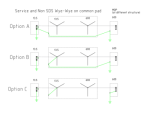Utilities like wye-wye for two reasons. First it’s a 3 leg transformer instead of a 5 leg. In fact you can just use 3 single phase transformers. Plus you can use thinner insulation because it only has to be insulated to line-neutral levels. Wye-wye is slightly cheaper all things considered. Second is lower cost to repair...because you can just swap out a single phase transformer instead of the whole thing. But here are the negatives. X0 passes through so a ground fault on the primary passes through to the secondary and vice versa. Second circulating currents are blocked in delta-wye but you get parasitic circulating currents in wye-wye. Third delta-wye phase shifts everything 60 degrees so it splits faults and kind of self balances unbalanced loads to a degree, and cancels all even harmonics where wye-wye doesn’t.
So lots of reasons to love delta-wye.
So lots of reasons to love delta-wye.


